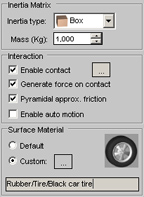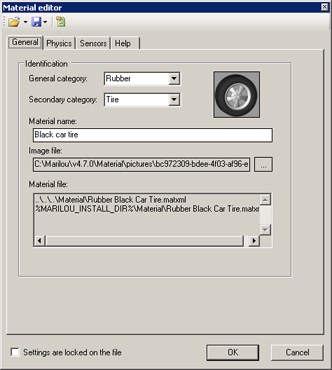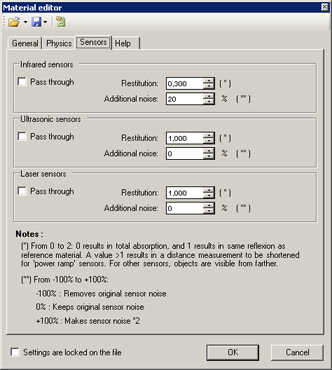Using physics Materials.
The geometry dynamics behavior is determined by a set of physics properties (Materials) like : static/viscous friction, energy restitution, slip, forces dependent slip, sensors management, etc. Each geometry can embed its own physics material : on collision of two geometries, the materials are mixed in order to produce a realistic behavior.
 |
Double click on a physics entity in order to show the Modify panel: You can choose to apply the Default material or choose/create a Custom one. Materials can be read/write from/in XML files. Using files is the best way to share the materials from a project to another or to share Materials from a geometry to another in the same document. If you don't use a material file, the properties are stored directly in the PHX file. |
|
Sub panel |
Description |
 |
Material general definition. Note that like other resources, the Material files path are stored with a relative and an absolute path (see also resources path). Like devices, you can use the settings:
|
 |
Bounce: Value from 0 to 2. 0 for hard stop on contact, 1 results in total force restitution. A value >1 amplify the bounce. Mixed bounce= max ( bg1, bg2 ) Rolling Damping: Rolling damping is applied when an object rolls over another ( sphere, cylinder and capsule in contact). The coef. represents the quantity of energy (angular speed) lost per second. You can choose how g1 and g2 coefficients are mixed. Damping value: 0 for disabling the damping contribution. 1 = maximum damping, >1 is used for very damped surfaces in combinaison with 'average mixing mode'. (in this case mixed coef is ranged by [0,1]) Friction: N is the surface contact normal. mu=0 results in a frictionless contact. Mixed MU = ( mug1+mug2 ) / 2 FDS (Force Dependant Slip): FDS is an effect that causes the contacting surfaces to side past each other with a velocity that is proportional to the force that is being applied tangentially to that surface. Use FDS=0 for disabling the feature. Tire typical value is 0.01 in direction1, 0.20 in direction2 (tangential). Mixed FDS(dirX) = max ( FDS[dirX][g1] , FDS[dirX][g2] ) |
 |
For each sensor type, the Material defines how the geometry interacts with the emitted value (IR, US, Laser). If 'Pass through' is checked, the sensor will not 'see' the surface. Otherwise it is possible to apply a restitution factor that is relative to a perfect surface (reference material) for the selected sensor type. (*) From 0 to 2: 0 results in total absorption, and 1 results in same reflexion as the reference material. A value >1 results in a distance measurement to be shortened for 'power ramp' type sensors. For other sensors, objects are visible from farther. (**) From -100% to +100%:
|
|
Documentation v4.7 (18/01/2015), Copyright (c) 2015 anyKode. All rights reserved.
|
|
What do you think about this topic? Send feedback!
|